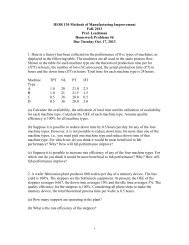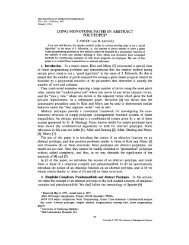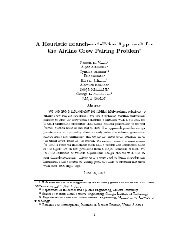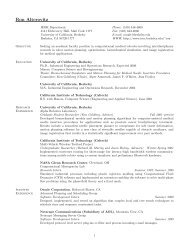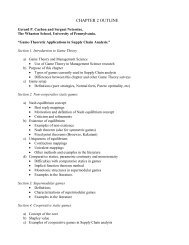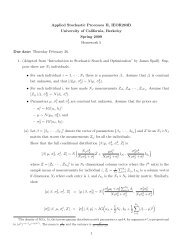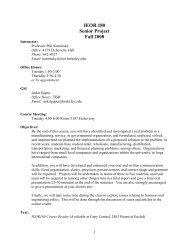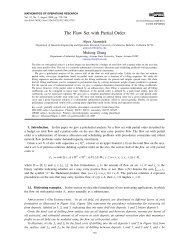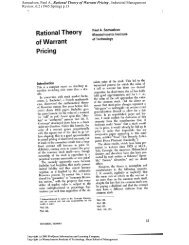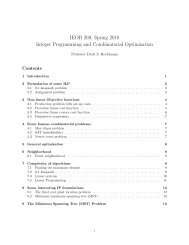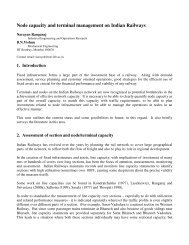A transmission-constrained unit commitment method in ... - CiteSeerX
A transmission-constrained unit commitment method in ... - CiteSeerX
A transmission-constrained unit commitment method in ... - CiteSeerX
Create successful ePaper yourself
Turn your PDF publications into a flip-book with our unique Google optimized e-Paper software.
298<br />
( )<br />
C.-L. Tseng et al.rDecision Support Systems 24 1999 297–310<br />
reschedul<strong>in</strong>g of some generat<strong>in</strong>g <strong>unit</strong>s and may <strong>in</strong>cur significant costs. This paper presents a <strong>method</strong> for solv<strong>in</strong>g<br />
the <strong>unit</strong> <strong>commitment</strong> problem which takes <strong>transmission</strong> constra<strong>in</strong>ts <strong>in</strong>to account. A first attempt to <strong>in</strong>corporate<br />
AC load flow constra<strong>in</strong>ts <strong>in</strong> <strong>unit</strong> <strong>commitment</strong> optimization was detailed <strong>in</strong> Ref. wx 9 with promis<strong>in</strong>g although<br />
limited computational test<strong>in</strong>g. At present, the computational requirements of that approach would be prohibitive<br />
for practical size problems but that might change with the rapid development <strong>in</strong> computation technology.<br />
In this paper, the <strong>transmission</strong> constra<strong>in</strong>ts will be formulated as l<strong>in</strong>ear constra<strong>in</strong>ts based on a DC power flow<br />
model. Pang et al. have considered the <strong>transmission</strong> <strong>constra<strong>in</strong>ed</strong> <strong>unit</strong> <strong>commitment</strong> problem <strong>in</strong> Ref. w11x<br />
us<strong>in</strong>g a<br />
dynamic programm<strong>in</strong>g <strong>method</strong>. In Ref. w12 x, Shaw has proposed a practical <strong>method</strong> for solv<strong>in</strong>g the security-<strong>constra<strong>in</strong>ed</strong><br />
<strong>unit</strong> <strong>commitment</strong> problem us<strong>in</strong>g the Lagrangian relaxation approach. This approach relaxes not only the<br />
demand constra<strong>in</strong>ts and the sp<strong>in</strong>n<strong>in</strong>g reserve constra<strong>in</strong>ts, but also the <strong>transmission</strong> constra<strong>in</strong>ts us<strong>in</strong>g multipliers.<br />
Shaw describes two <strong>method</strong>s <strong>in</strong> his paper w12 x, a direct <strong>method</strong> and an <strong>in</strong>direct <strong>method</strong>. The former takes full<br />
account of the <strong>transmission</strong> constra<strong>in</strong>ts <strong>in</strong> the optimization phase, while the latter does so only <strong>in</strong> locat<strong>in</strong>g a<br />
feasible solution. The conclusion of Ref. w12x<br />
favors the direct <strong>method</strong>.<br />
In this paper, we employ a three-phase algorithmic scheme w14–16x<br />
to solve the <strong>unit</strong> <strong>commitment</strong> problem.<br />
The three phases <strong>in</strong>clude dual optimization, a feasibility phase and <strong>unit</strong> de<strong>commitment</strong>. Algorithmically, the<br />
dual optimization phases of most Lagrangian relaxation-based approaches are alike. These approaches differentiate<br />
<strong>in</strong> obta<strong>in</strong><strong>in</strong>g a feasible solution. In this paper we will present a robust feasibility <strong>method</strong> us<strong>in</strong>g l<strong>in</strong>ear<br />
programm<strong>in</strong>g. The obta<strong>in</strong>ed feasible schedule will then be improved by a <strong>unit</strong> de<strong>commitment</strong> <strong>method</strong>. It has<br />
been shown <strong>in</strong> Ref. w15x<br />
that <strong>unit</strong> de<strong>commitment</strong> not only improves solution quality generally, but also mitigates<br />
unpredictable effects due to heuristics <strong>in</strong> the first two phases. In this paper, we apply our <strong>method</strong> to a practical<br />
test problem, which <strong>in</strong>volves more than 2200 buses and 2500 <strong>transmission</strong> l<strong>in</strong>es, and other small-scale test<br />
problems as well.<br />
This paper is organized as follows: Section 2 gives the formulation of the <strong>unit</strong> <strong>commitment</strong> problem. A<br />
three-phase Lagrangian relaxation algorithm is presented <strong>in</strong> Section 3. Section 4 gives some numerical results.<br />
We conclude the paper <strong>in</strong> Section 5.<br />
2. Problem formulation<br />
We first def<strong>in</strong>e the follow<strong>in</strong>g nomenclature.<br />
t: Index for time Ž ts0, PPP , T .<br />
b: Index for the number of buses Ž bs1, PPP , B.<br />
L b:<br />
Index set of <strong>unit</strong>s at bus b<br />
i: Index for the number of <strong>unit</strong>s Ž igL , bs1, PPP , B.<br />
b<br />
l : Index for <strong>transmission</strong> l<strong>in</strong>es Ž ls1, PPP , L.<br />
G l b: L<strong>in</strong>e flow distribution factor for <strong>transmission</strong> l<strong>in</strong>e l due to the net <strong>in</strong>jection at bus<br />
b<br />
F l :<br />
The <strong>transmission</strong> capacity on the <strong>transmission</strong> l<strong>in</strong>e l<br />
u it:<br />
Zero-one decision variable <strong>in</strong>dicat<strong>in</strong>g whether <strong>unit</strong> i is up or down <strong>in</strong> time period<br />
t.<br />
x it:<br />
State variable <strong>in</strong>dicat<strong>in</strong>g the length of time that <strong>unit</strong> i has been up or down <strong>in</strong> time<br />
period t<br />
ti<br />
on :<br />
The m<strong>in</strong>imum number of periods <strong>unit</strong> i must rema<strong>in</strong> on after it has been turned on<br />
ti<br />
off :<br />
The m<strong>in</strong>imum number of periods <strong>unit</strong> i must rema<strong>in</strong> off after it has been turned<br />
off<br />
p it:<br />
Variable <strong>in</strong>dicat<strong>in</strong>g the amount of power <strong>unit</strong> i is generat<strong>in</strong>g <strong>in</strong> time period t<br />
pi<br />
m<strong>in</strong> :<br />
M<strong>in</strong>imum rated capacity of <strong>unit</strong> i<br />
p max :<br />
Maximum rated capacity of <strong>unit</strong> i<br />
i




